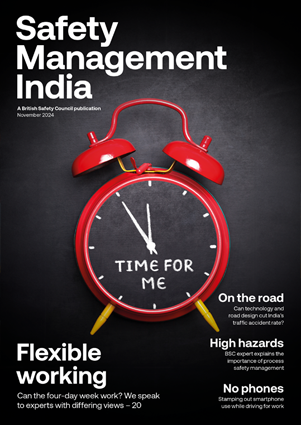Workers could be damaging their hearing while wearing headphones for recreational use at work, so it’s vital that employers take action to control the risks.
Features
Listen up: why headphones pose a risk to workers’ hearing
Most of the population are being exposed to increasing levels of sound every day, whether it is from noise (sound that we generally don’t want to hear) generated by cars, planes, trains or just the bustle of a busy street; or from recreational sound exposure (RSE), sound which we choose to hear as part of our pastimes and entertainment – such as live music, sporting events, gaming, listening to music or watching films. The effect of this increase in exposure to noise and sound is a growing risk to our hearing health.
In fact, perhaps the biggest change and subsequent risk to hearing health over the past few years has been the increasing level of RSE from headphones use for individual entertainment, a trend that accelerated during the Covid-19 pandemic.
 There are two groups of headphone users at work: those who are required to use headphones for work-related activities and those who are permitted to use headphones at work for personal use. Photograph: iStock
There are two groups of headphone users at work: those who are required to use headphones for work-related activities and those who are permitted to use headphones at work for personal use. Photograph: iStock
The 2022 Ofcom report Media Nations UK estimates that adults in the UK consume around five hours per day of screen time outside of work, many hours of which, especially in the 16 to 34-year-old group, will be while using headphones.
So why is an increase in the RSE an important issue for employers?
Simply put, workers could be damaging their hearing due to levels of RSE and their employer, along with the employer’s insurer, could end up taking the blame or paying for it – if a worker who suffers hearing loss or other hearing health damage successfully pursues a compensation claim against the business.
So how might this happen? Since the introduction of the Control of Noise at Work Regulations 2005 (CNAWR), most employers have taken action to identify noisy activities and processes at work which could pose a risk to workers’ hearing.
As a result, most sources of high noise levels in occupational settings, like factories, have been identified and addressed through various mitigation strategies and by mandating that workers wear personal hearing protection, like earmuffs or earplugs. However, there are emerging noise risks that could be problematic for employers, and these are increasingly found in professional or ‘low risk’ sectors and workplaces, rather than the traditional ‘noisy’ sectors, like manufacturing.
The emerging risks come from the use of headphones in the workplace.
There are two groups of headphone users at work: those who are required to use headphones for work-related activities and those who are permitted to use headphones at work for personal use (such as listening to music or other reproduced sound, like a podcast, in an open-plan office, for example). Under the Noise at Work Regulations, employers have a clear responsibility to manage the sound exposure levels of members of their staff in the first group. However, employers may also have a responsibility to manage sound exposure for some or all of those in the second group as well.
 Headphones on sale in Europe are restricted to a maximum output of 100dB when used with a mobile handset but may produce higher output levels with other sources. Photograph: iStock
Headphones on sale in Europe are restricted to a maximum output of 100dB when used with a mobile handset but may produce higher output levels with other sources. Photograph: iStock
What kind of sound exposure levels might arise from using headphones?
Headphones on sale in Europe are restricted to a maximum output of 100dB when used with a mobile handset but may produce higher output levels with other sources. According to the action levels in the CNAWR, the maximum safe listening period at 100dB is likely to be between 15 and 30 minutes in any 24-hour period.
Although it’s unlikely that a member of staff would wear headphones and listen at 100dB for their entire working day, they are in control of the volume, so an employer has no way of knowing if the employee’s sound exposure level remains below the upper exposure action value in the CNAWR of 85dBA averaged over an eight-hour working day or over a working week.
Therefore, if a member of staff were to listen at an average of say 94dBA for their eight-hour working day, they could receive a sound dose which is equivalent to four times that permitted under the Noise at Work Regulations.
An issue could therefore arise if the worker’s RSE (for example, when listening to music through headphones while working), is significant in comparison to the noise exposure levels allowed by the CNAWR (and allowed under the employer’s own workplace noise exposure controls and rules), and this contributes to the individual later suffering hearing loss or damage.
If a member of staff who uses headphones for work (or is allowed to wear headphones for recreational listening while working), suffers hearing loss or other hearing health harm, they could potentially pursue a claim for personal injury damages against their employer and the employer’s insurer.
 Stephen Wheatley
Stephen Wheatley
If the employer is unable to prove that they took the steps necessary to protect the worker’s hearing in line with the CNAWR and their general duty of care, then they, and their insurers, may become liable for a compensation claim for hearing loss, some, or all of which, is related to hearing damage caused by RSE.
How can an employer reduce the risks?
So, what kind of steps can employers take to reduce the risk of hearing damage among workers who use headphones, both for work purposes and for recreational listening while at work?
As stated, employers must first remember that they have an obligation under the CNAWR to ensure that their employees are not over exposed to sound as well as noise through workplace exposures. However, there is a grey area in the law as to whether this applies equally to those who are required to wear headphones for their job and those who are permitted to wear personal listening devices during work time.
But if we assume there is the real possibility that this could apply, some practical ways of reducing the risks include:
- Assessing the risks to workers’ hearing from headphone use for all purposes at work and introducing control measures – such as monitoring employees’ sound exposure from headphone use
- Educating employees about the risk of hearing damage from headphone use – for example, warning workers not to exceed the safe volume level set on devices like headphones and mobile phones and to use the volume limiter if one is available on the device; and encouraging workers to download a hearing safeguarding app, which tracks the total listening time and listening sound level and lets the user know if they are overdoing their sound exposure
- If employees are using headphones for recreational listening at work, encouraging them to upgrade from ‘ear bud’ type devices to good quality ‘over-ear’ headphones which will reduce the background noise so they can listen at a lower level; or to invest in noise-cancelling headphones that will block out the noise around them, therefore avoiding the need to turn up the volume to a dangerous level to hear the music or spoken word properly over background noise
- Consider investing in hearing safeguarding technology for headphones, headsets and in-ear devices. A variety of types and software are available, including devices that continuously measure the sound level being delivered to headphones and then automatically intervene to reduce the sound level if the hearing dose rate is likely to exceed the recommended levels; and devices that can be pre-set so the sound is fixed at a maximum safe listening level.
So, it is a good idea for all potentially affected employers to identify any members of staff at risk of hearing damage from using headphones and to start protecting them.
Stephen Wheatley is a founder director of the UK Hearing Conservation Association and founder and CEO of LimitEar/HearAngel Ltd, which develops and produces technologies which reduce the risk of hearing damage for occupational and recreational headphone users.
The article has been reviewed by Clare Forshaw, chair of the UK Hearing Conservation Association and occupational health and hygiene partner at Park Health & Safety.
For more information see: hearingconservation.org.uk


FEATURES
Why changes to recycling legislation in England are an opportunity, not a burden
By on 12 November 2024

Road safety in India: could better road safety, vehicle technology and enforcement make driving for work safer?
By Orchie Bandyopadhyay on 10 November 2024
India has a poor road safety record, and research shows that commercial vehicles are a major contributor to the problem, with trucks estimated to be the single largest vehicle type involved in impacts leading to fatalities. We look at solutions that could make driving for work and the roads in general safer – from in-vehicle technology that warns truck drivers about unsafe behaviour to improving the design features of major highways.

